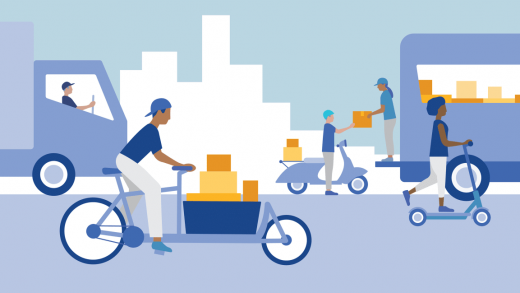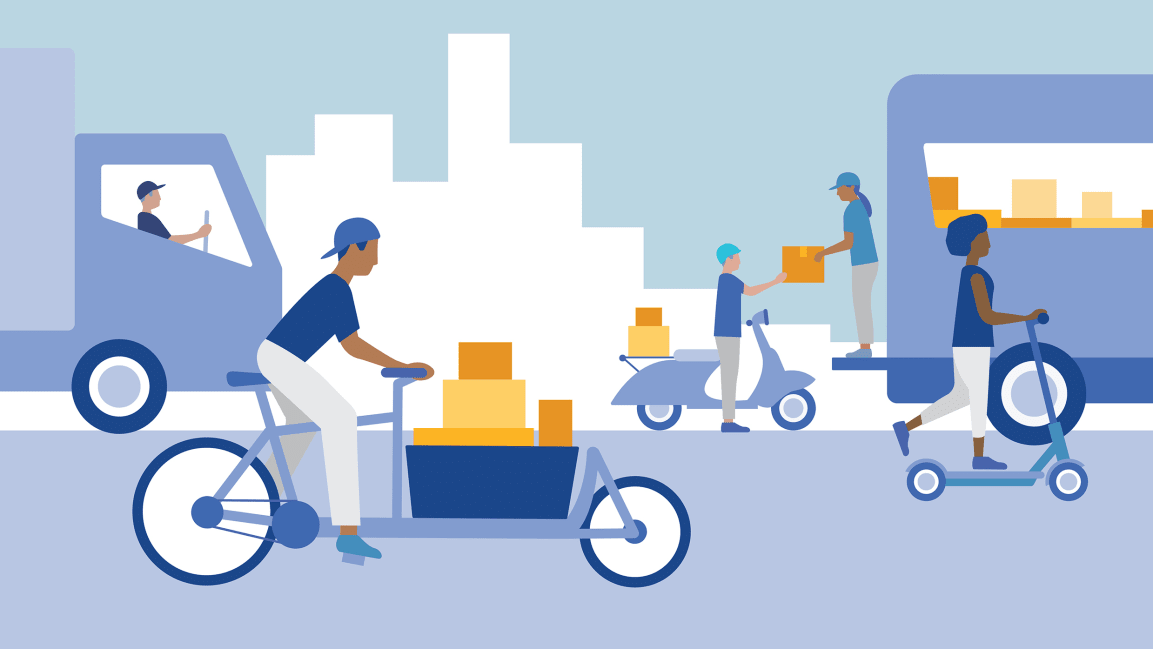One-day deliveries are breaking our cities
In New York City, 1.5 million packages are delivered daily to people’s doorsteps—three times as many as in the beginning of the decade, according to the Center of Excellence for Sustainable Urban Freight Systems. This has worsened traffic in a city already beset by gridlock. As the New York Times points out, the George Washington Bridge, the main thoroughfare for delivery trucks, has become the most congested route in the country.
New York is hardly alone. Delivery trucks are disrupting cities all over the United States, as for-profit companies use public roads to bring packages to customers’ doorsteps, clogging up the streets and polluting the air. Amazon Prime pioneered the practice of fast, free shipping, forcing competitors to do the same. As a result, consumers now expect their packages to appear in a matter of days—and sometimes hours—placing tremendous pressure on local logistics systems and infrastructure. Delivery companies often turn public sidewalks and streets into temporary warehouses to organize, distribute, and deliver packages. They park illegally (and wrack up hundreds of thousands of dollars in fines as a result). Direct-to-consumer shipping isn’t likely to ease up anytime soon. So how can we alleviate the stress on cities? Here are four ideas:
Redistribute packages for the good of the city
In smaller European cities like Amsterdam, large logistics companies aren’t allowed to ship directly to people’s front doors. Tightened emission regulation prevents large trucks from entering the city center. Instead, packages are redistributed outside the urban center to specialized teams that are allowed to enter the city center.
This mean that the most challenging part of the delivery journey—getting goods to their final destination, which is commonly called the last mile—is left in the most capable hands. It also means that various logistics companies aggregate their packages, reducing the need for multiple trucks to drive down the same streets.
If New York adopted a similar system, for instance, just one truck would deliver packages to all the apartment buildings on a street, compared with three or more trucks (one for UPS, one for FedEx, one for DHL, etc.). This would cut down on traffic and pollution.
Realistically, it would only work if local governments got involved and started playing an active role in determining what comes into a city. For instance, they might mandate that delivery trucks can only enter the city once they have optimized their cargo for what is good for the region and its citizens—not just their own commercial interests. Would such a system slow down deliveries? It’s tough to say and would likely vary from one city to the next. But it stands to reason that fewer delivery vehicles would mean less traffic and smoother deliveries.
Work together on the last mile
During research for one of Smart Design’s projects in London, we met Mark, a delivery van driver for one of the major e-commerce retailers. We shadowed him for a day and interviewed him after.
Delivering packages in the center of London is spectacularly difficult. Besides struggling to find parking spots, he got tickets when he parked illegally and had to pay for the tickets himself. He did not receive any employee benefits, because he is part of the gig economy. He had to eat the costs of his van maintenance and fuel and he was under constant pressure to deliver on time as his job depended on it. We weren’t very surprised to hear he quit not much later; he just couldn’t cope with the stress and long hours.
We learned that in a city like London, it can be more efficient for delivery vans to drive to strategically placed meet-up points and distribute their packages to a team of cyclists and pedestrians. This team takes packages to their final destination while the vans go back to their depot to reload and drive to another meet-up point. This delivery method—which was piloted in London last year—allows for four times as many packages to be delivered during one shift, while reducing pollution and congestion. After a successful pilot, the city is awaiting next steps.
Pool curb data to improve our cities
Delivery drivers have their own mental map of preferred parking spots, distributed across their typical route. That map might take into account factors such as how easy a spot is for loading and unloading packages, how long they can park there, and how likely it is they’ll get a ticket. This so-called curb data is locked inside their brains. But if it were publicly available, it would optimize pick-up and drop-off for delivery trucks—not to mention ride-hail services.
Unsurprisingly, companies like Uber have started using curb data as a currency to gain operating privileges in cities. Uber collects data on rider pick-ups and drop-offs, and shares it with cities, which can help a city better plan for and regulate ride sharing. In return, the cities cut Uber some slack over how they operate, giving the company an edge over the competition. Logistics companies obviously have different incentives, so they’re not likely to contribute data to a bigger pool that benefits everyone. Cities, then, should start creating their own data sets. They can do so by leveraging—for instance—the cameras spread out across cities and using algorithms to pinpoint popular or successful pick-up or drop-off locations.
Alternatively, the data could be gathered through crowdsourcing. A company called Coord is doing exactly that with tools that allow people to map curb features, like parking signs and loading zones. Opening up data to everyone allows delivery drivers to be more precise and efficient planning their stops.
A universal locker to rule them all
Instead of delivering a single package to a single front door, why not make better use of centralized lockers? They’re safe, don’t require customers to be home, and can accept deliveries any time of day. They also make deliveries cheaper and more efficient, as drivers spend less time parking and running up to individuals’ homes.
Unfortunately, existing lockers are the property of Amazon or UPS, and only take Amazon and UPS deliveries respectively. This is problematic, because smaller players in the delivery market can’t afford their own locker system. And even if they could, a multitude of locker systems would make for a poor user experience. Who wants to run around to 10 different lockers just to get all their deliveries?
Instead, centralized lockers should be accessible to any delivery service. Delivery companies could pool the money they would save delivering to universal lockers to pay for the hardware in public places.
Next steps
The conventional wisdom of a free market economy suggests that healthy competition will drive down the price of deliveries, which in turn benefits consumers. Of all the things that can be done to address the problems with home deliveries, a common thread is that when the various parties involved work together, conditions improve for everyone. Regulators can think of ways to reward behavior that benefits the city and its citizens over profit for logistics companies. Logistics companies can bask in the positive PR of working with cities, instead of disrupting and profiting off them. Shoppers, too, might want to be a little more mindful about ordering online. Maybe don’t order five sizes to try on at home and send a couple—or all—back. We’re not only consumers, we’re also citizens. And right now this so-called healthy competition is taking too much of a toll on the health of the city.
This is the second installment in a two-part series on the impact of e-commerce on cities. Read the first installment, “Free shipping is quietly changing the design of your favorite products,” here.
(44)



